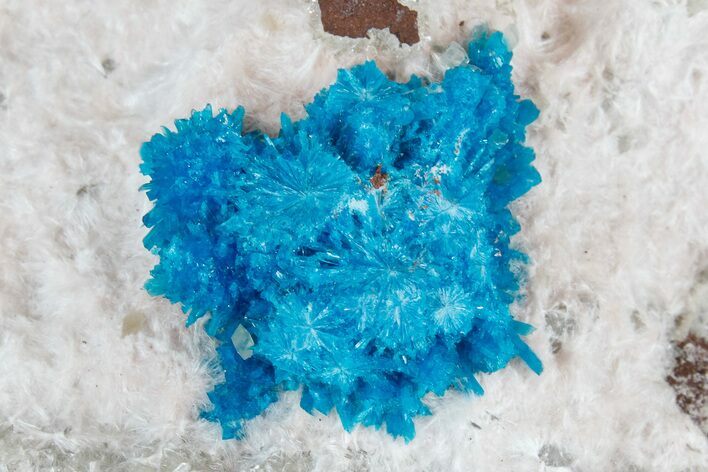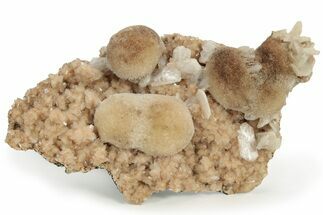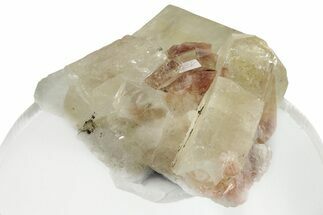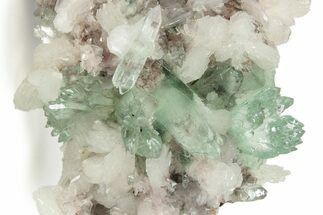This Specimen has been sold.
Vibrant Blue Cavansite Clusters on Stilbite & Mordenite - India
This is a teal cavansite (pentagonite?) crystal aggregation with rhombohedral calcite crystals, on a fibrous mordenite and micro-stilbite crystal encrusted matrix. This specimen was collected from the Wagholi Quarry in the Pune district of India. The base of the matrix has been cut flat for aesthetic presentation without the need for a display stand.
Pentagonite is dimorphic to cavansite, and without x-ray diffraction analysis, it's nearly impossible to accurately identify whether the specimen is cavansite or pentagonite. The elongated crystals indicate that this specimen could in fact be pentagonite, however without additional testing, it's safest to label this as cavansite.
Note: While fibrous mordenite is not considered an asbestos mineral, the crystals are still small enough that they can become airborne and enter the lungs. It is suggested that this specimen not be handled frequently or held near the mouth.
Pentagonite is dimorphic to cavansite, and without x-ray diffraction analysis, it's nearly impossible to accurately identify whether the specimen is cavansite or pentagonite. The elongated crystals indicate that this specimen could in fact be pentagonite, however without additional testing, it's safest to label this as cavansite.
Note: While fibrous mordenite is not considered an asbestos mineral, the crystals are still small enough that they can become airborne and enter the lungs. It is suggested that this specimen not be handled frequently or held near the mouth.
About Cavansite
Cavansite, the name of which is derived from its chemical composition, calcium vanadium silicate, is a deep blue, crystal-forming mineral. It occurs in basaltic and andesitic rocks and is typically associated with zeolites. Discovered in 1967 in Malheur County, Oregon, cavansite is a relatively rare mineral. The vast majority of it comes from the Deccan Traps, a large igneous province and one of the largest volcanic features on earth, in the Pune Province of India.
Cavansite tends to form deep blue crystal aggregates, generally as balls up to a couple centimeters in size. These balls are typically found on top of zeolite beds. Because of its rich color and relative rarity, cavansite is sought after by mineral collectors.
Cavansite, the name of which is derived from its chemical composition, calcium vanadium silicate, is a deep blue, crystal-forming mineral. It occurs in basaltic and andesitic rocks and is typically associated with zeolites. Discovered in 1967 in Malheur County, Oregon, cavansite is a relatively rare mineral. The vast majority of it comes from the Deccan Traps, a large igneous province and one of the largest volcanic features on earth, in the Pune Province of India.
Cavansite tends to form deep blue crystal aggregates, generally as balls up to a couple centimeters in size. These balls are typically found on top of zeolite beds. Because of its rich color and relative rarity, cavansite is sought after by mineral collectors.
Stilbite is a tectosilicate mineral of the zeolite group that is commonly found in zeolite deposits. Crystals often form flowery bowtie or hourglass-shaped structures and come in a variety of colors. Some of the most beautiful colorations are the pink or peach tints.
SPECIES
Cavansite (Pentagonite?), Calcite, Stilbite & Mordenite
LOCATION
Wagholi Quarry, Pune, India
SIZE
Matrix 2.5 x 2.4"
CATEGORY
ITEM
#176801
 Reviews
Reviews














